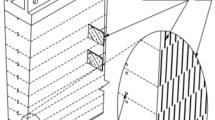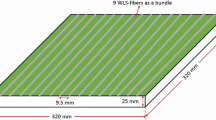Abstract
Plastic scintillators (PSs) embedded with wavelength-shifting fibers are widely used in high-energy particle physics, such as in muon taggers, as well as in medical physics and other applications. In this study, a simulation package was built to evaluate the effects of the diameter and layout of optical fibers on the light yield with different configurations. The optimal optical configuration was designed based on simulations and validated using two PS prototypes under certain experimental conditions. A top veto tracker (TVT) for the JUNO-TAO experiment, comprising four layers of 160 strips of PS, was designed and evaluated. The threshold was evaluated when the muon tagging efficiency of a PS strip was >99%. The efficiency of three layer out of four layer of TVT is >99%, even with a tagging efficiency of a single strip as low as 97%, using a threshold of 10 photoelectrons and assuming a 40% silicon PM photon detection efficiency.















Similar content being viewed by others
Data availability
The data that support the findings of this study are openly available in Science Data Bank at https://www.doi.org/10.57760/sciencedb.08970 and https://www.scidb.cn/anonymous/RnpNSkJ6
References
P.A. Zyla, Particle Data Group, Review of particle physics. Prog. Theor. Exp. Phys. 08, 08 (2020). https://doi.org/10.1093/ptep/ptaa104
M.Y. Guan, M.-C. Chu, J. Cao et al., A parametrization of the cosmic-ray muon flux at sea-level. https://doi.org/10.48550/arXiv.1509.06176
C. Patrignani, Particle Data Group et al., Review of particle physics. Chin. Phys. C 40, 100001 (2016). https://doi.org/10.1088/1674-1137/40/10/100001
Z.Y. Guo, L. Bathe-Peters, S.M. Chen, (JNE Collaboration) et al., Muon flux measurement at China Jinping Underground Laboratory. Chin. Phys. C 45, 025001 (2021). https://doi.org/10.1088/1674-1137/abccae
E. Barbuto, C. Bozza, M. Cozzi et al., Atmospheric muon flux measurements at the external site of the Gran Sasso Lab. Nucl. Instrum. Methods Phys. Res. Sect. A 525, 485–495 (2004). https://doi.org/10.1016/j.nima.2004.01.078
W.H. Trzaska, M. Slupecki, L. Bandac et al., Cosmic-ray muon flux at Canfranc Underground Laboratory. Eur. Phys. J. C 79, 721 (2019). https://doi.org/10.1140/epjc/s10052-019-7239-9
JUNO Collaboration, JUNO physics and detector. Prog. Part. Nucl. Phys. 123, 0146–6410 (2022). https://doi.org/10.1016/j.ppnp.2021.103927
JUNO Collaboration and T. Adam et al., JUNO conceptual design report. physics.ins-det. https://ui.adsabs.harvard.edu/abs/2015arXiv150807166A
JUNO Collaboration and Angel Abusleme et al., TAO conceptual design report: a precision measurement of the reactor antineutrino spectrum with sub-percent energy resolution. physics.ins-det. https://ui.adsabs.harvard.edu/abs/2020arXiv200508745J
E. Aprile, F. Agostini, M. Alfonsi, XENON1T Collaboration, Conceptual design and simulation of a water Cherenkov muon veto for the XENON1T experiment. JINST 9, P11006 (2014). https://doi.org/10.1088/1748-0221/9/11/P11006
E. Aprile, J. Aalbers, F. Agostini, XENON Collaboration, Projected WIMP sensitivity of the XENONnT dark matter experiment. J. Cosmol. Astropart. Phys. 2020, 031 (2020). https://doi.org/10.1088/1475-7516/2020/11/031
M. Christmann, P. Achenbach, S. Aulenbacher et al., Light dark matter searches with DarkMESA. PoS, EPS-HEP2021, 398, 129 (2022). https://pos.sissa.it/398/129. https://doi.org/10.22323/1.398.0129
T. Alexander, D. Alton, K. Arisaka et al., DarkSide search for dark matter. JINST 8, C11021 (2013). https://doi.org/10.1088/1748-0221/8/11/C11021
A. Pocar, EXO-200, nEXO collaboration, Searching for neutrino-less double beta decay with EXO-200 and nEXO. Nucl. Part. Phys. Proc. 265–266, 42–44 (2015). https://doi.org/10.1016/j.nuclphysbps.2015.06.011
D. Tosi, EXO collaboration, Search for double beta decay with EXO-200. AIP Conf. Proc. 1560, 187–189 (2013). https://doi.org/10.1063/1.4826749
R. Gornea, EXO-200 collaboration, Double beta decay in liquid xenon. J. Phys. Conf. Ser. 179, 012004 (2009). https://doi.org/10.1088/1742-6596/179/1/012004
J.B. Birks, The theory and practice of scintillation counting (1964). https://www.slac.stanford.edu/spires/find/books
Y. Zhezher, Telescope Array collaboration, Study of muons in Ultra-High-Energy cosmic-ray air showers with the telescope array experiment. Phys. Atom. Nucl. 82, 685–688 (2019). https://doi.org/10.1134/S1063778819660517
A. Erhart, NUCLEUS collaboration, Development of an organic plastic scintillator based muon veto operating at sub-kelvin temperatures for the NUCLEUS experiment, in 19th International Workshop on Low Temperature Detectors. https://doi.org/10.1007/s10909-022-02842-5
J.W. Seo, E.J. Jeon, W.T. Kim et al., A feasibility study of extruded plastic scintillator embedding WLS fiber for AMoRE-II muon veto. Nucl. Instrum. Methods A 1039, 167123 (2022). https://doi.org/10.1016/j.nima.2022.167123
K.J. Thomas, E.B. Norman, A.R. Smith et al., Installation of a muon veto for low background gamma spectroscopy at the LBNL low-background facility. Nucl. Instrum. Methods Phys. Res. Sect. A 724, 47–53 (2013). https://doi.org/10.1016/j.nima.2013.05.034
A. Pla-Dalmau, A.D. Bross, K.L. Mellott, Low-cost extruded plastic scintillator. Nucl. Instrum. Methods A 466, 482–491 (2001). https://doi.org/10.1016/S0168-9002(01)00177-2
A.A. Moiseev, P.L. Deering, R.C. Hartman et al., High efficiency plastic scintillator detector with wavelength-shifting fiber readout for the GLAST large area telescope. Nucl. Instrum. Methods A 583, 372–381 (2007). https://doi.org/10.1016/j.nima.2007.09.040
V.M. Thakur, A. Jain, P. Ashokkumar et al., Design and development of a plastic scintillator based whole body beta/gamma contamination monitoring system. Nucl. Sci. Tech. 32, 47 (2021). https://doi.org/10.1007/s41365-021-00883-1
U. Holm, K. Wick, Radiation stability of plastic scintillators and wave length shifters. IEEE Trans. Nucl. Sci. 36, 579–583 (1989). https://doi.org/10.1109/23.34504
C. Bloise, S. Ceravolo, F. Cervelli et al., Design, assembly and operation of a Cosmic Ray Tagger based on scintillators and SiPMs. Nucl. Instrum. Methods A 1045, 167538 (2023). https://doi.org/10.1016/j.nima.2022.167538
P. Buzhan, A. Karakash, Hand-foot monitors for nuclear plants based on scintillator–WLS–SiPM technology. J. Phys Conf. Ser. 1689, 012011 (2020). https://doi.org/10.1088/1742-6596/1689/1/012011
W. Bugg, Yu. Efremenko, S. Vasilyev, Large plastic scintillator panels with WLS fiber readout; optimization of components. Nucl. Instrum. Methods A 758, 91–96 (2014). https://doi.org/10.1016/j.nima.2014.05.055
J.N. Dong, Y.L. Zhang, Z.Y. Zhang et al., Position-sensitive plastic scintillator detector with WLS-fiber readout. Nucl. Sci. Tech. 29, 117 (2018). https://doi.org/10.1007/s41365-018-0449-2
Y. Yang, C.P. Yang, J. Xin et al., Performance of a plastic scintillation fiber dosimeter based on different photoelectric devices. Nucl. Sci. Tech. 32, 120 (2021). https://doi.org/10.1007/s41365-021-00965-0
T. Adam et al., The OPERA experiment target tracker. Nucl. Instrum. Methods A 577, 523–539 (2007). https://doi.org/10.1016/j.nima.2007.04.147
P. Adamson, K. Alexandrov, G. Alexeev et al., The MINOS scintillator calorimeter system. IEEE Trans. Nucl. Sci. 49, 861–863 (2002). https://doi.org/10.1109/TNS.2002.1039579
Y.P. Wang, C. Hou, X.D. Sheng et al., Testing and analysis of the plastic scintillator units for LHAASO-ED. Rad. Det. Tech. Meth. 54, 513–519 (2021). https://doi.org/10.1007/s41605-021-00274-5
F. Aharonian, Q. An, Axikegu et al., Performance test of the electromagnetic particle detectors for the LHAASO experiment. Nucl. Instrum. Methods A. 1001, 165193 (2021). https://doi.org/10.1016/j.nima.2021.165193
J. Evans, MINOS collaboration, The MINOS experiment: results and prospects. Adv. High Energy Phys. 2013, 182537 (2013). https://doi.org/10.1155/2013/182537
S. Orsi, PAMELA collaboration, PAMELA: a payload for antimatter matter exploration and light nuclei astrophysics. Nucl. Instrum. Methods A 580, 880–883 (2007). https://doi.org/10.1016/j.nima.2007.06.051
V. Andreev, V. Balagura, B. Bobchenko et al., A high granularity scintillator hadronic-calorimeter with SiPM readout for a linear collider detector. Nucl. Instrum. Methods A 540, 368–380 (2005). https://doi.org/10.1016/j.nima.2004.12.002
D.J. Thompson, C.A. Wilson-Hodge, Fermi gamma-ray space telescope. arXiv:2210.12875
S. Procureur, Muon imaging: principles, technologies and applications. Nucl. Instrum. Methods Phys. Res. Sect. 878, 169–179 (2018). https://doi.org/10.1016/j.nima.2017.08.004
K. Morishima, M. Kuno, A. Nishio et al., Discovery of a big void in Khufu’s Pyramid by observation of cosmic-ray muons. Nature 552, 386–390 (2017). https://doi.org/10.1038/nature24647
A. Zenoni, Historical building stability monitoring by means of a cosmic ray tracking system, in 4th International Conference on Advancements in Nuclear Instrumentation Measurement Methods and their Applications. IEEE Nuclear Science Symposium Conference Record, pp. 1–8 (2015). https://doi.org/10.1109/ANIMMA.2015.7465542
J. Marteau, D. Gibert, N. Lesparre et al., Muons tomography applied to geosciences and volcanology. Nucl. Instrum. Methods A 695, 23–28 (2012). https://doi.org/10.1016/j.nima.2011.11.061
S. Oguri, Y. Kuroda, Y. Kato et al., Reactor antineutrino monitoring with a plastic scintillator array as a new safeguards method. Nucl. Instrum. Methods A 757, 33–39 (2014). https://doi.org/10.1016/j.nima.2014.04.065
A.Sh. Georgadze, V.M. Pavlovych, O.A. Ponkratenko et al., A remote reactor monitoring with plastic scintillation detector. arXiv:1610.05884
P.R. Scovell, A. Vacheret, A. Baird et al., Low background anti-neutrino monitoring with an innovative composite solid scintillator detector, in 2013 IEEE Nuclear Science Symposium and Medical Imaging Conference and Workshop on Room-Temperature Semiconductor Detectors, pp. 1–7 (2013). https://doi.org/10.1109/NSSMIC.2013.682954
F. Capozzi, E. Lisi, A. Marrone, Mapping reactor neutrino spectra from TAO to JUNO. Phys. Rev. D 102, 056001 (2020). https://doi.org/10.1103/PhysRevD.102.056001
S. Agostinelli, J. Allison, K. Amako et al., Geant4-a simulation toolkit. Nucl. Instrum. Methods Phys. Res. Sect. A 506, 250–303 (2003). https://doi.org/10.1016/S0168-9002(03)01368-8
S. Riggi, P. La Rocca, E. Leonora et al., Geant4 simulation of plastic scintillator strips with embedded optical fibers for a prototype of tomographic system. Nucl. Instrum. Methods A 624, 583–590 (2010). https://doi.org/10.1016/j.nima.2010.10.012
W.Z. Xu, Y.F. Liu, Z.Q. Tan et al., Geant4 simulation of plastic scintillators for a prototype uSR spectrometer. Nucl. Sci. Tech. 24, 4 (2013). https://doi.org/10.13538/j.1001-8042/nst.2013.04.011
P. Lecoq, Scintillation detectors for charged particles and photons, in Particle Physics Reference Library (Springer, Cham, 2020), pp. 45–89 . https://doi.org/10.1007/978-3-030-35318-6-3
M. Li, Z.M. Wang, C.M. Liu et al., Performance of compact plastic scintillator strips with wavelength shifting fibers using a photomultiplier tube or silicon photomultiplier readout. Nucl. Sci. Tech. 34, 2 (2023). https://doi.org/10.1007/s41365-023-01175-6
H. Yang, G. Luo, T. Yu et al., MuGrid: a scintillator detector towards cosmic muon absorption imaging. Nucl. Instrum. Methods A 1042, 167402 (2022). https://doi.org/10.1016/j.nima.2022.167402
Hoton Technology Co. Beijing Hoton Nuclear Technology Co., Ltd. http://www.hoton.com.cn/English/index.html
C. Tur, V. Solovyev, J. Flamanc et al., Temperature characterization of scintillation detectors using solid-state photomultipliers for radiation monitoring applications. Nucl. Instrum. Methods A 620, 351–358 (2010). https://doi.org/10.1016/j.nima.2010.03.141
E. Dietz Laursonn, Detailed studies of light transport in optical components of particle detectors. Aachen, Tech. Hochsch. https://inspirehep.net/literature/1505685
X.L. Qian, H.Y. Sun, C. Liu et al., Simulation study on performance optimization of a prototype scintillation detector for the GRANDProto35 experiment. Nucl. Sci. Tech. 32, 51 (2021). https://doi.org/10.1007/s41365-021-00882-2
T. Gaisser, Cosmic-ray showers reveal muon mystery. APS Phys. 9, 125 (2016). https://doi.org/10.1103/Physics.9.125
P. Shukla, S. Sankrith, Energy and angular distributions of atmospheric muons at the Earth. Int. J. Mod. Phys. A 33, 1850175 (2018). https://doi.org/10.1142/S0217751X18501750
Semiconductor Components Industries, LLC. Cherry Semiconductor (1999–2023)
Author information
Authors and Affiliations
Contributions
All authors contributed to the study conception and design. Material preparation, data collection, and analysis were performed by Guang Luo, Pei-Zhi Lu, and Min Li. The first draft of the manuscript was written by Guang Luo, and all authors commented on previous versions of the manuscript. All authors read and approved the final manuscript.
Corresponding authors
Ethics declarations
Conflict of interest
The authors declare that they have no competing interests.
Additional information
This work was supported by the School of Physics at Sun Yat-sen University, China.
Rights and permissions
Springer Nature or its licensor (e.g. a society or other partner) holds exclusive rights to this article under a publishing agreement with the author(s) or other rightsholder(s); author self-archiving of the accepted manuscript version of this article is solely governed by the terms of such publishing agreement and applicable law.
About this article
Cite this article
Luo, G., Hor, Y.K., Lu, PZ. et al. Design optimization of plastic scintillators with wavelength-shifting fibers and silicon photomultiplier readouts in the top veto tracker of the JUNO-TAO experiment. NUCL SCI TECH 34, 99 (2023). https://doi.org/10.1007/s41365-023-01263-7
Received:
Revised:
Accepted:
Published:
DOI: https://doi.org/10.1007/s41365-023-01263-7




